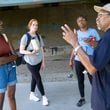Halloween should be about treats, but some tricks such as dangerous situations can quickly ruin the fun. The following trick-or-treating safety tips can help you and your kids avoid issues.
COSTUME SAFETY
Costumes and other components can create hazards if you're not careful. The following tips from the Centers for Disease Control and the National Safety Council will help you make sure your child's disguise doesn't cause any hazards:
- Look for light-colored, flame-resistant costumesLook for masks, wigs, costumes and other components that are labeled as flame-resistant or made of flame-resistant fabrics such as polyester or nylon. Also choose light-colored costumes when possible since they're easier for drivers to spot at night.
- Look for a proper fitMake sure all masks, shoes and other parts of your child's costume fit well. He or she should be able to see well and walk without tripping over a costume that drags the ground or because of shoes that are too large.
- Take care with makeupBuy only nontoxic Halloween makeup, and always test it in a small area first, the CDC recommends. Remove it before bedtime to help prevent irritation.
- Use safe accessoriesUse swords, knives and other accessories made of soft materials that won't cause injury if your child falls on them.
- Make your child more visible.The CDC suggests adding reflective tape to your child's costume and treat bag to make him or her more visible.
- Protect their eyesSkip wearing decorative contact lenses to avoid injuring your eyes, and don't let your kids wear them.
ROAD SAFETY
Drive carefully and keep your kids safe as they navigate neighborhood streets with the following tips:
- Slow down and be cautiousIf you're driving on Halloween, slow down in residential neighborhoods and watch out for trick-or-treaters who may unexpectedly dart into the street. Especially if they're wearing dark costumes, they can be difficult to see.
- Be visibleTurn your headlights on, even if it's still light outside, so you'll be more visible to trick-or-treaters.
- Arm trick-or-treaters with flashlightMake sure your trick-or-treaters carry a flashlight with fresh batteries, but teach them to carry it facing downward so they don't temporarily blind oncoming drivers.
- Stick to sidewalksWalk on sidewalks when possible, and if they're not available, walk on the left side of the road so you're facing traffic.
- Cross the street safelyCross streets only at the corner, and never cross between parked vehicles.
- Make sure kids are supervisedIf you're not accompanying your kids, ensure that they're going with another adult or an older, responsible young person if they're under 12. CANDY SAFETYMake sure you child's candy doesn't cause any harm with the following tips:
- Inspect your child's candyTell your kids to wait until you can look through their candy at home before they eat any. Tampering is rare, but it does happen. Look for any tears in wrappers, tiny pinholes, or anything that looks discolored or unusual. Throw out anything that isn't commercially wrapped, unless it's a homemade treat from someone you personally know well.
- Check for allergensIf your child has a food allergy, read the ingredient label of commercially wrapped treats to make sure it doesn't contain any allergens. Skip homemade treats, since you can't be sure of what they contain.
- Look for teal pumpkinsIf you see a teal pumpkin at a home, that signifies that it's safe for trick-or-treaters with food allergies since the homeowners offer non-food treats like small toys. Look for homes that display these if your child has allergies, and provide this welcoming sign of safe treats for kids who visit your home.
- Check for choking hazardsCheck through non-candy treats to make sure they're not a choking hazard to your child if he or she is younger. Also go through their candy and eliminate any hard candies or any other items they could choke on.
SAFE TRICK OR TREAT LOCATIONS
Choose the safest locations for your child to visit with the following tips:
- Visit 'trunk or treat' eventsOrganizations such as churches often hold trunk or treat events where people decorate their opened trucks and hand out candy. This helps children stay in a confined area and avoid streets and traffic.
- Hit the mallMalls sometimes have Halloween events where stores give out candy to children in costume. You'll avoid traffic and other outdoor hazards while ensuring that weather won't be a factor.
- Check with neighborhood associationsIf you live in a community with a neighborhood association, these organizations often have information about which houses are handing out candy. The association may also host a clubhouse party for the holiday.
- Use Nextdoor's treat mapThe social network site for neighborhoods has a Halloween treat map that lets you and your neighbors "advertise" that you'll be handing out Halloween candy. You can use it to plan the best route for your trick-or-treaters.
- Know which houses to avoidSeveral states prohibit registered sex offenders from handing out candy on Halloween, and at least one, Maryland, requires them to post "No candy at this residence" signs. You can also check the U.S. Department of Justice's website for links to your state's sex offender registry or download a mobile app that you can use along the way to tell you which homes to avoid.
About the Author
Editors' Picks
The Latest





